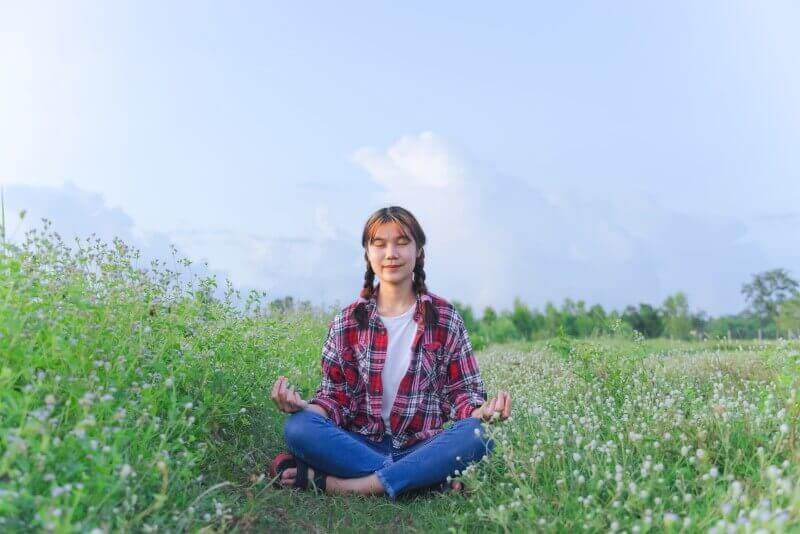Welcome to the busy world we live in, a place where stress and anxiety have become unwelcome companions. Dealing with stress isn’t just a luxury; it’s a skill we all secretly wish we had for survival.
So, here’s the deal: let’s tackle this stress-filled roller coaster together, not as victims but as masters of our mental universe. Are you ready for the ride? Let’s explore meditation for anxiety and depression.
How meditation helps with stress and anxiety

Recent scientific studies have shed light on the structural changes in the brain induced by regular meditation. Notably, the prefrontal cortex and hippocampus, associated with emotional regulation and memory, show increased activity, contributing to enhanced cognitive function.
Meditation and Feel-Good Chemicals
When you meditate, it influences these tiny messengers in your brain called neurotransmitters. Think of them as mood boosters. Meditation increases one called serotonin, making you feel good, and it helps balance out others like dopamine and norepinephrine to keep your emotions steady and negative thoughts away.
Chilling Out with Cortisol
Meditation is like a superhero against the stress hormone, cortisol. It works to lower cortisol levels, bringing a sense of calm. And guess what? This not only helps you chill but also brings some cool benefits for your overall health, like making your immune system stronger and giving you better sleep.
Mind and Body BFFs in Meditation
Meditation is cool because it puts a spotlight on the connection between your mind and body. By paying attention to how your body feels and how you breathe, meditation helps you live in the moment.
Types of Meditation for Stress and Anxiety
A. Mindfulness Meditation: Meditation For Anxiety Relief

Scientific studies consistently show that mindfulness meditation is super effective for severe anxiety. Using brain imaging techniques, researchers found changes in the brain’s structure related to improved emotional control.
A 2018 study in “Psychological Science” revealed that people doing mindfulness meditation had stronger connections in brain areas tied to attention and control, backing up its stress-reducing benefits.
How to do Mindfulness Meditation:
- Find a Quiet Space: Choose a quiet place where you won’t be disturbed. Sit comfortably with your back straight.
- Focus on Breath: Close your eyes and bring your attention to your breath. Observe the sensation of each inhale and exhale.
- Be Present: Gently redirect your focus to the present moment whenever your mind starts to wander. Notice thoughts and feelings without judgement and bring your attention back to the breath.
- Start Gradually: Begin with short sessions and gradually extend the duration as you become more comfortable with the practice.
B. Loving-Kindness Meditation: Nurturing Compassion for Inner Peace

The Loving-Kindness Meditation technique is a real champ for emotional well-being. It can be a really good meditation for social anxiety.
A 2019 review in the “Journal of Contextual Behavioral Science” confirmed that this meditation significantly reduces anxiety and depression symptoms. Cultivating compassion through Loving-Kindness Meditation even boosts oxytocin, the “love hormone,” promoting social bonds and emotional resilience.
How to do Loving-Kindness Meditation:
- Choose a Comfortable Posture: Sit or lie down in a comfortable position. Close your eyes and take a few deep breaths to relax.
- Focus on Loving-Kindness: Picture someone you care about deeply. Silently repeat phrases like “May you be happy, may you be healthy, may you be safe, may you be at ease.”
- Extend Kindness: Expand this practice to include others in your life, gradually encompassing all beings. Cultivate feelings of compassion and goodwill.
C. Transcendental Meditation: Mantras for Mental Clarity

Transcendental Meditation is one of the best meditation for severe anxiety. A 2014 study in the “Journal of Alternative and Complementary Medicine” found that folks practising Transcendental Meditation had lower stress hormone levels, including cortisol, compared to others.
Repeating the mantra in Transcendental Meditation helps manage anxiety by triggering a special response in the body.
How to do Transcendental Meditation:
- Select a Mantra: Choose a simple and personally meaningful mantra. Sit comfortably with your eyes closed.
- Repeat the Mantra: Silently repeat the chosen mantra in your mind. Allow it to become a focal point, gently returning to it whenever your mind starts to wander.
- 15-20 Minutes Daily: Practise Transcendental Meditation for 15-20 minutes twice a day. Find a quiet time and space to ensure optimal focus and relaxation.
- End Calmly: After your meditation, sit quietly with your eyes closed for a few moments before resuming your daily activities.
D. Visualization Meditation: Crafting Serene Mental Landscapes

Visualisation can be a perfect 1 minute meditation for anxiety. Let’s talk about the science behind visualisation meditation—it’s a stress-busting superhero. A 2016 study in “Frontiers in Psychology” showed that visualisation techniques make the autonomic nervous system happy, promoting relaxation.
People using guided imagery had a slower heart rate and more activity in the calming part of the nervous system, showing they were in a super chill state.
How to do Visualization Meditation:
- Choose a Relaxing Scene: Sit or lie down in a comfortable position. Close your eyes and imagine a serene place, such as a beach or a forest.
- Engage Your Senses: Envision the details of your chosen scene. Feel the warmth of the sun, hear the rustling leaves, and smell the ocean breeze.
- Deep Breaths: Take slow, deep breaths as you immerse yourself in the mental landscape. Allow any tension to melt away.
- Stay Present: If your mind wanders, gently guide it back to the visualisation. Practise regularly to enhance your ability to create and enjoy tranquil mental landscapes.
E. Raga Chikitsa: Melodic Meditation for Anxiety and Depression

Although we’re still figuring out Raga Chikitsa through research, early studies hint at a cool connection between Indian classical ragas and how we feel. Some ragas are like musical healers:
Raga Yaman: Think of it as a calm friend. Raga Yaman is known for bringing balance and tranquillity to our emotions.
Raga Bhairavi: This one is like a musical hug. It’s believed to make you feel devoted and might help reduce stress while making your mind clearer.
Raga Darbari: Picture this as your slow-motion soundtrack. This raga is perfect for a meditative vibe, giving you a path to relax and find emotional harmony.
In 2020, a review in “Frontiers in Neuroscience” pointed out that music therapy, including Raga Chikitsa, can help with anxiety and depression. The beautiful tunes and rhythms in Indian classical music talk directly to our emotional centers in the brain.
Tips to Include Meditation in Daily Life
Integrating meditation into your daily routine need not be daunting. Consider these tips for seamlessly infusing moments of tranquillity into your busy schedule:
- 1-Minute Meditation for Anxiety : Inhale and Exhale: Take just a minute to focus on your breath. Inhale deeply, exhale fully. You can do this micro-meditation anywhere, and it offers instant relief and better mental health in the long term.
- Quick Guided Meditation for Anxiety: If you’re new to meditation, try guided meditation apps for brief sessions. These apps provide step-by-step instructions, making it easy for even the busiest individuals to incorporate mindfulness.
- Listen to Ragas: For beginners exploring meditation, listening to calming Indian classical ragas can be a soothing experience. The melodic tunes create a serene atmosphere, aiding in relaxation of different parts of your body and focus.
- Be Patient: Remember, it’s okay to start small. Meditation is a skill that develops over time. Be patient with yourself as you explore different techniques and find what works best for you.
- Consistency is Key: Whether it’s a 1-minute breath exercise or a guided meditation session, consistency matters. Aim to make meditation a regular part of your routine, even if it’s just a few minutes each day.
- Create a Quiet Space: Find a quiet spot where you won’t be disturbed. It could be a corner of your room, a park bench, or even a quiet room at work. Creating a dedicated space enhances the effectiveness of your meditation practice.
- Use Technology to Your Advantage: Guided meditation apps offer flexibility. Use them during short breaks, lunch hours, or whenever you have a moment to spare. Embrace technology as a supportive tool while exploring meditation for anxiety relief.
Can meditation reduce anxiety? Now we know that it does and in an extremely effective way. In the hustle of modern life, meditation shines like a guiding light of calm. It’s not just a practice; it’s a soothing remedy for the challenges we face.
Meditation for anxiety and depression is a holistic way to improve mental well-being, with diverse techniques for different needs. By smoothly blending these practices into everyday life, individuals can open a way to less stress and greater overall happiness. It’s like a secret path to serenity amid life’s chaos.
Frequently Asked Questions
Q 1: How Long Should I Meditate Each Day?
Ans- Begin with a manageable duration, such as 10-15 minutes, gradually adjusting to your comfort level.
Q 2: Is Meditation a Replacement for Therapy?
Ans – While beneficial, meditation complements therapeutic approaches rather than replacing them. It’s not a substitute for professional therapy.
Q 3: What if I Can’t Clear My Mind?
Ans – Clearing the mind is not the goal. Acknowledge thoughts without judgement, gently redirecting focus to your chosen point of meditation.
Q 4: Can Meditation Help with Physical Health Issues?
Ans- While primarily focusing on mental well-being, meditation’s positive effects can indirectly contribute to improved physical health, including stress management and immune system support.
References
https://www.frontiersin.org/articles/10.3389/fpsyg.2021.613821/full
https://www.ncbi.nlm.nih.gov/pmc/articles/PMC7704181/
https://www.ncbi.nlm.nih.gov/pmc/articles/PMC8272667/
https://www.sciencedirect.com/science/article/abs/pii/S0165032718310498
https://www.journalppw.com/index.php/jppw/article/view/15140
https://onlinelibrary.wiley.com/doi/10.1002/cpp.1893
https://www.thepermanentejournal.org/doi/10.7812/TPP/13-102
https://www.sciencedirect.com/science/article/abs/pii/S0005796718300299?via%3Dihub
https://pubmed.ncbi.nlm.nih.gov/24395196/

Anjani Kumar Shrivastava, a distinguished yoga expert with decades of experience, brings healing and wisdom through yoga therapy, meditation, and Ayurvedic principles. His remarkable Read more


